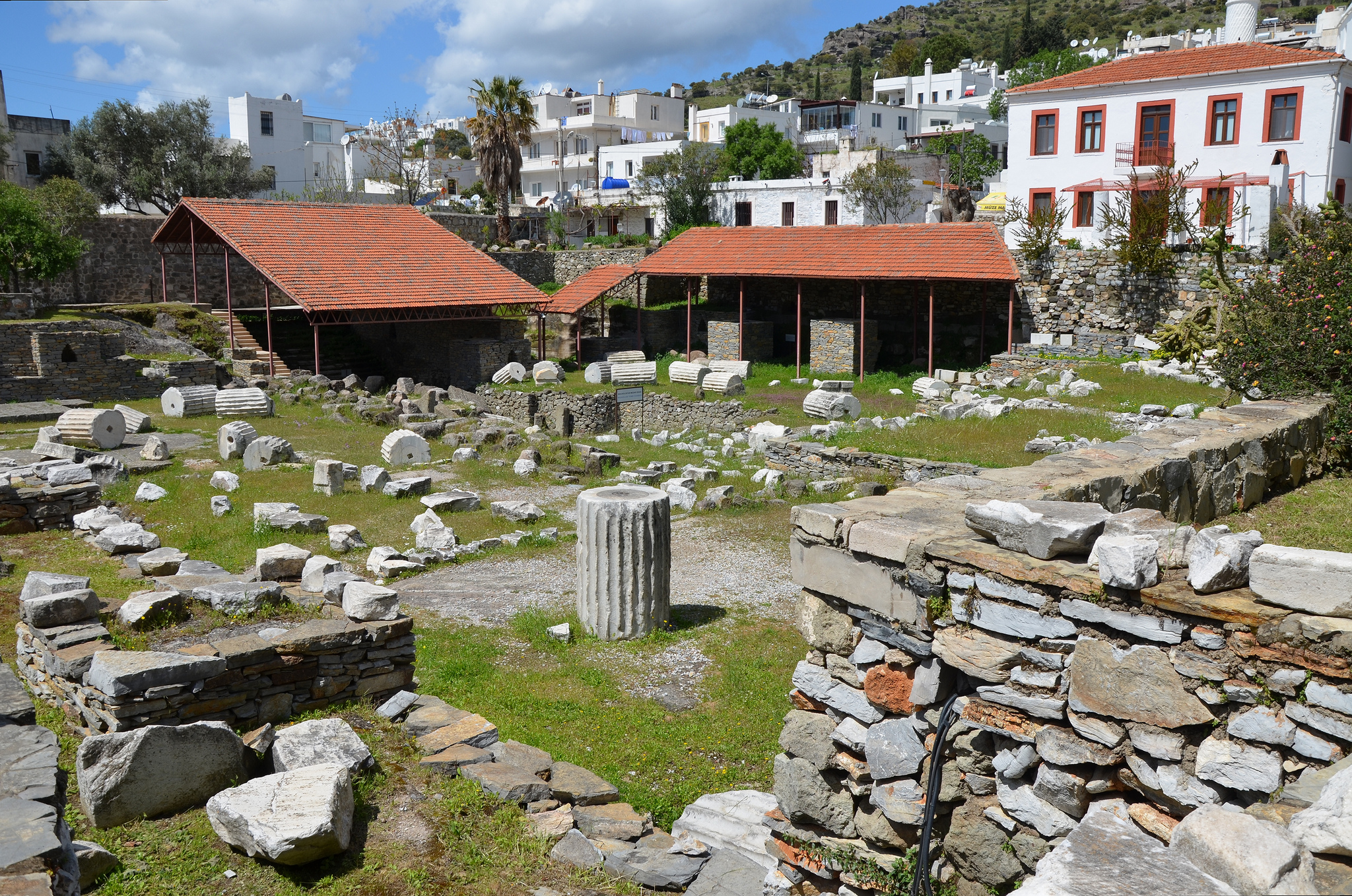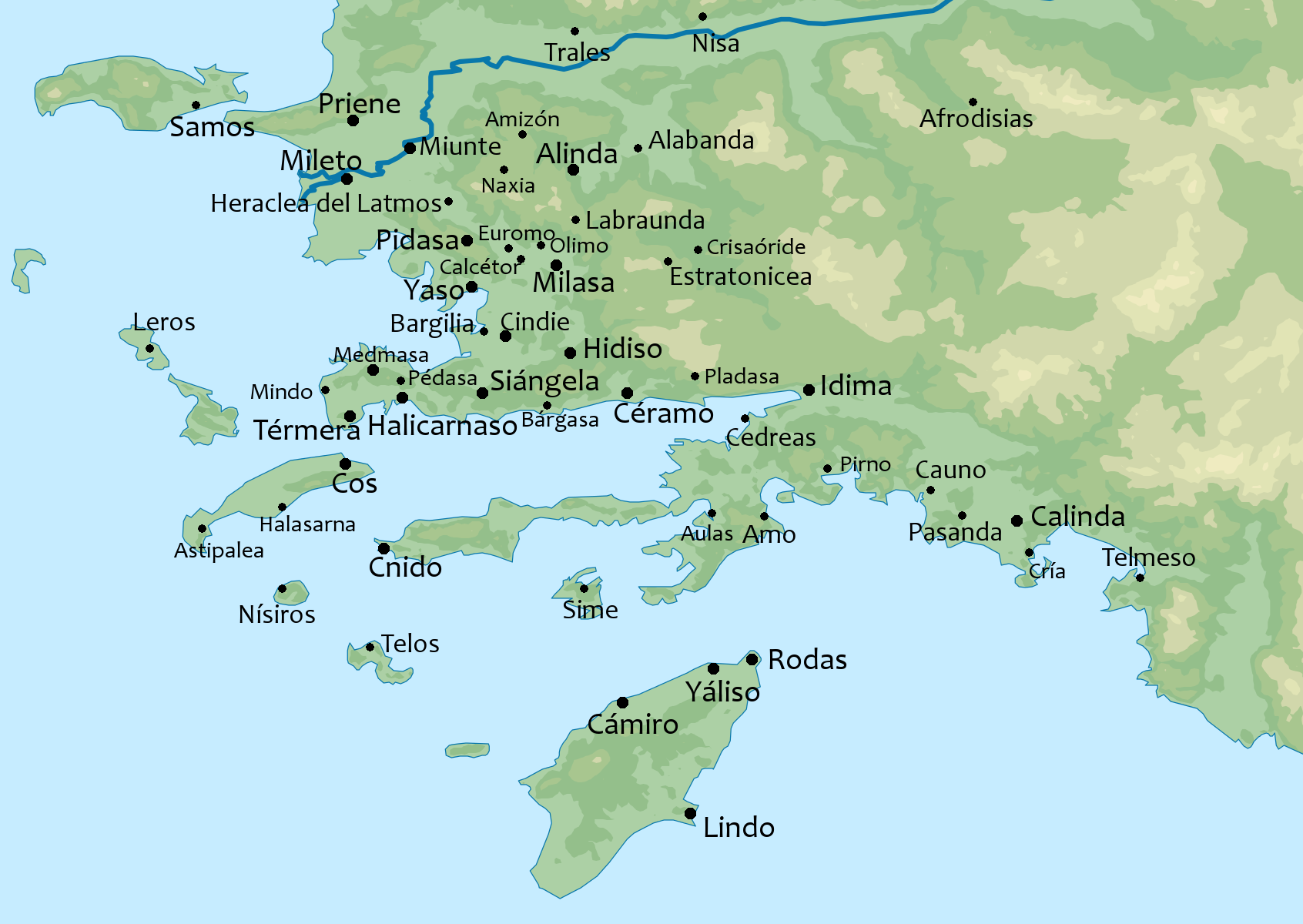|
Dorian Pentapolis
The Doric or Dorian Hexapolis ( grc-gre, Δωρικὴ Ἑξάπολις or Δωριέων Ἑξάπολις) was a federation of six cities of Dorian foundation in southwest Asia Minor and adjacent islands, largely coextensive with the region known as Doris or Doris in Asia (), and included: *Cos, on the island of Cos *Cnidus in Caria; *Halicarnassus in Caria; *Lindus, on the island of Rhodes; *Ialysus on Rhodes; and *Camirus on Rhodes. The members of this ''hexapolis'' celebrated a festival, with games, on the Triopian promontory near Cnidus, in honour of the Triopian Apollo; the prizes in those games were brazen tripods, which the victors had to dedicate in the temple of Apollo; and Halicarnassus was struck out of the league, because one of her citizens carried the tripod to his own house before dedicating it in the temple of Apollo. The ''hexapolis'' thus became the Doric Pentapolis. ( Herod. i. 144.) Pliny (v. 28) says, ''Caria mediae Doridi circumfunditur ad mare utroque ... [...More Info...] [...Related Items...] OR: [Wikipedia] [Google] [Baidu] |
Halicarnassus
Halicarnassus (; grc, Ἁλικαρνᾱσσός ''Halikarnāssós'' or ''Alikarnāssós''; tr, Halikarnas; Carian: 𐊠𐊣𐊫𐊰 𐊴𐊠𐊥𐊵𐊫𐊰 ''alos k̂arnos'') was an ancient Greek city in Caria, in Anatolia. It was located in southwest Caria, on an advantageous site on the Gulf of Gökova, which is now in Bodrum, Turkey.} The city was famous for the Mausoleum of Halicarnassus, also known simply as the Tomb of Mausolus, whose name provided the origin of the word "mausoleum". The mausoleum, built from 353 to 350 BC, ranked as one of the seven wonders of the ancient world. Halicarnassus' history was special on two interlinked issues. Halicarnassus retained a monarchical system of government at a time when most other Greek city states had long since rid themselves of their kings. And secondly, while their Ionian neighbours rebelled against Persian rule, Halicarnassus remained loyal to the Persians and formed part of the Persian Empire until Alexander the ... [...More Info...] [...Related Items...] OR: [Wikipedia] [Google] [Baidu] |
Ialysus
Ialysus or Ialysos ( gr, Ἰάλυσος), also Ialyssus or Ialyssos (Ἰάλυσσος), or Ielyssus or Ielyssos (Ἰήλυσσος), was a city of ancient Rhodes. It was one of the three ancient Doric cities in the island, and one of the six towns constituting the Doric hexapolis. It was situated only six stadia to the south-west of the city of Rhodes, and it would seem that the rise of the latter city was the cause of the decay of Ialysus; for in the time of Strabo it existed only as a village. Pliny the Elder did not consider it as an independent place at all, but imagined that Ialysus was the ancient name of Rhodes. Orychoma, the citadel, was situated above Ialysus, and still existed in the time of Strabo. It is supposed by some that Orychoma was the same as the fort Achaea or Achaia, which is said to have been the first settlement of the Heliadae in the island; at any rate, Achaia was situated in the territory of Ialysus, which bore the name Ialysia. The city is mentioned by ... [...More Info...] [...Related Items...] OR: [Wikipedia] [Google] [Baidu] |
Asia
Asia (, ) is one of the world's most notable geographical regions, which is either considered a continent in its own right or a subcontinent of Eurasia, which shares the continental landmass of Afro-Eurasia with Africa. Asia covers an area of , about 30% of Earth's total land area and 8.7% of Earth's total surface area. The continent, which has long been home to the majority of the human population, was the site of many of the first civilizations. Its 4.7 billion people constitute roughly 60% of the world's population. In general terms, Asia is bounded on the east by the Pacific Ocean, on the south by the Indian Ocean, and on the north by the Arctic Ocean. The border of Asia with Europe is a historical and cultural construct, as there is no clear physical and geographical separation between them. It is somewhat arbitrary and has moved since its first conception in classical antiquity. The division of Eurasia into two continents reflects East–West cultural, ling ... [...More Info...] [...Related Items...] OR: [Wikipedia] [Google] [Baidu] |
Ptolemy
Claudius Ptolemy (; grc-gre, Πτολεμαῖος, ; la, Claudius Ptolemaeus; AD) was a mathematician, astronomer, astrologer, geographer, and music theorist, who wrote about a dozen scientific treatises, three of which were of importance to later Byzantine, Islamic, and Western European science. The first is the astronomical treatise now known as the ''Almagest'', although it was originally entitled the ''Mathēmatikē Syntaxis'' or ''Mathematical Treatise'', and later known as ''The Greatest Treatise''. The second is the ''Geography'', which is a thorough discussion on maps and the geographic knowledge of the Greco-Roman world. The third is the astrological treatise in which he attempted to adapt horoscopic astrology to the Aristotelian natural philosophy of his day. This is sometimes known as the ''Apotelesmatika'' (lit. "On the Effects") but more commonly known as the '' Tetrábiblos'', from the Koine Greek meaning "Four Books", or by its Latin equivalent ''Qua ... [...More Info...] [...Related Items...] OR: [Wikipedia] [Google] [Baidu] |
Thucydides
Thucydides (; grc, , }; BC) was an Athenian historian and general. His '' History of the Peloponnesian War'' recounts the fifth-century BC war between Sparta and Athens until the year 411 BC. Thucydides has been dubbed the father of " scientific history" by those who accept his claims to have applied strict standards of impartiality and evidence-gathering and analysis of cause and effect, without reference to intervention by the gods, as outlined in his introduction to his work. He also has been called the father of the school of political realism, which views the political behavior of individuals and the subsequent outcomes of relations between states as ultimately mediated by, and constructed upon, fear and self-interest. His text is still studied at universities and military colleges worldwide. The Melian dialogue is regarded as a seminal work of international relations theory, while his version of Pericles' Funeral Oration is widely studied by political theorists, ... [...More Info...] [...Related Items...] OR: [Wikipedia] [Google] [Baidu] |
Ceramic Gulf
A ceramic is any of the various hard, brittle, heat-resistant and corrosion-resistant materials made by shaping and then firing an inorganic, nonmetallic material, such as clay, at a high temperature. Common examples are earthenware, porcelain, and brick. The earliest ceramics made by humans were pottery objects (''pots,'' ''vessels or vases'') or figurines made from clay, either by itself or mixed with other materials like silica, hardened and sintered in fire. Later, ceramics were glazed and fired to create smooth, colored surfaces, decreasing porosity through the use of glassy, amorphous ceramic coatings on top of the crystalline ceramic substrates. Ceramics now include domestic, industrial and building products, as well as a wide range of materials developed for use in advanced ceramic engineering, such as in semiconductors. The word "''ceramic''" comes from the Greek word (), "of pottery" or "for pottery", from (), "potter's clay, tile, pottery". The earliest known men ... [...More Info...] [...Related Items...] OR: [Wikipedia] [Google] [Baidu] |
Hamaxitus (Caria)
Hamaxitus was a town of ancient Caria mentioned by Pliny the Elder Gaius Plinius Secundus (AD 23/2479), called Pliny the Elder (), was a Roman author, naturalist and natural philosopher, and naval and army commander of the early Roman Empire, and a friend of the emperor Vespasian. He wrote the encyclopedic ... as being on north coast of the Cnidian Chersonesus. Its site is unlocated. References Populated places in ancient Caria Former populated places in Turkey Lost ancient cities and towns {{AncientCaria-geo-stub ... [...More Info...] [...Related Items...] OR: [Wikipedia] [Google] [Baidu] |
Pliny The Elder
Gaius Plinius Secundus (AD 23/2479), called Pliny the Elder (), was a Roman author, naturalist and natural philosopher, and naval and army commander of the early Roman Empire, and a friend of the emperor Vespasian. He wrote the encyclopedic '' Naturalis Historia'' (''Natural History''), which became an editorial model for encyclopedias. He spent most of his spare time studying, writing, and investigating natural and geographic phenomena in the field. His nephew, Pliny the Younger, wrote of him in a letter to the historian Tacitus: Among Pliny's greatest works was the twenty-volume work ''Bella Germaniae'' ("The History of the German Wars"), which is no longer extant. ''Bella Germaniae'', which began where Aufidius Bassus' ''Libri Belli Germanici'' ("The War with the Germans") left off, was used as a source by other prominent Roman historians, including Plutarch, Tacitus and Suetonius. Tacitus—who many scholars agree had never travelled in Germania—used ''Bella Germa ... [...More Info...] [...Related Items...] OR: [Wikipedia] [Google] [Baidu] |
Herodotus
Herodotus ( ; grc, , }; BC) was an ancient Greek historian and geographer from the Greek city of Halicarnassus, part of the Persian Empire (now Bodrum, Turkey) and a later citizen of Thurii in modern Calabria ( Italy). He is known for having written the ''Histories'' – a detailed account of the Greco-Persian Wars. Herodotus was the first writer to perform systematic investigation of historical events. He is referred to as " The Father of History", a title conferred on him by the ancient Roman orator Cicero. The ''Histories'' primarily cover the lives of prominent kings and famous battles such as Marathon, Thermopylae, Artemisium, Salamis, Plataea, and Mycale. His work deviates from the main topics to provide a cultural, ethnographical, geographical, and historiographical background that forms an essential part of the narrative and provides readers with a wellspring of additional information. Herodotus has been criticized for his inclusion of "legends and fa ... [...More Info...] [...Related Items...] OR: [Wikipedia] [Google] [Baidu] |
Doric Pentapolis
The Doric or Dorian Hexapolis ( grc-gre, Δωρικὴ Ἑξάπολις or Δωριέων Ἑξάπολις) was a federation of six cities of Dorian foundation in southwest Asia Minor and adjacent islands, largely coextensive with the region known as Doris or Doris in Asia (), and included: *Cos, on the island of Cos *Cnidus in Caria; *Halicarnassus in Caria; * Lindus, on the island of Rhodes; *Ialysus on Rhodes; and * Camirus on Rhodes. The members of this ''hexapolis'' celebrated a festival, with games, on the Triopian promontory near Cnidus, in honour of the Triopian Apollo; the prizes in those games were brazen tripods, which the victors had to dedicate in the temple of Apollo; and Halicarnassus was struck out of the league, because one of her citizens carried the tripod to his own house before dedicating it in the temple of Apollo. The ''hexapolis'' thus became the Doric Pentapolis. ( Herod. i. 144.) Pliny (v. 28) says, ''Caria mediae Doridi circumfunditur ad mare ut ... [...More Info...] [...Related Items...] OR: [Wikipedia] [Google] [Baidu] |
Greek Temple
Greek temples ( grc, ναός, naós, dwelling, semantically distinct from Latin , "temple") were structures built to house deity statues within Greek sanctuaries in ancient Greek religion. The temple interiors did not serve as meeting places, since the sacrifices and rituals dedicated to the respective ouranic (a god or goddess that does not reside on the Earth) deity took place outside them, within the wider precinct of the sanctuary, which might be large. Temples were frequently used to store votive offerings. They are the most important and most widespread building type in Greek architecture. In the Hellenistic kingdoms of Southwest Asia and of North Africa, buildings erected to fulfill the functions of a temple often continued to follow the local traditions. Even where a Greek influence is visible, such structures are not normally considered as Greek temples. This applies, for example, to the Graeco-Parthian and Bactrian temples, or to the Ptolemaic examples, which follow ... [...More Info...] [...Related Items...] OR: [Wikipedia] [Google] [Baidu] |







